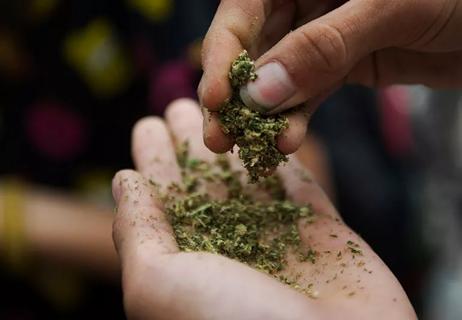Changing habits takes time and commitment

Changing a habit takes effort, whether you decide to nix a daily sugar fix, cut down on alcohol or stop smoking weed. But the payoffs are worth it. Feeling better and getting healthier are a given. But perhaps the biggest benefit is living with intention — making decisions that positively impact your life rather than letting habit or addiction determine your fate.
Advertisement
Cleveland Clinic is a non-profit academic medical center. Advertising on our site helps support our mission. We do not endorse non-Cleveland Clinic products or services. Policy
Although many people believe that using marijuana isn’t a big deal, it can significantly impact your life. Today’s marijuana is more potent — it has three times more high-producing tetrahydrocannabinol (THC) than it did 25 years ago. It can make you more intoxicated and increase your risk of developing marijuana use disorder (becoming addicted).
Is it time for a change? Addiction psychiatrist David Streem, MD, shares what signs indicate you have marijuana use disorder and how to quit smoking weed.
Want to know how to quit smoking marijuana? Dr. Streem shares these strategies to help you kick the habit:
“Whenever you try to change an unhealthy behavior, think about how the behavior started in the first place,” advises Dr. Streem. “Addressing any underlying reasons why you started that behavior is key to successfully changing the habit.”
People often turn to marijuana to alleviate:
Cannabis may provide temporary relief, but it doesn’t treat the underlying condition. Talk to your healthcare provider or a therapist about safer, more effective solutions that you can try instead. When you find a new way to address the underlying issue, it’s easier to stop using marijuana.
Advertisement
The method you choose isn’t as important as how much preparation you do, says Dr. Streem. “The best predictor of success is how much planning you put into it. It should be the same as changing your diet or starting an exercise plan,” he says. “Look at your life and figure out the best strategy for you.” Once you settle on your path forward, choose a quit date. You can do this in one of two ways:
Let people know that you’re quitting smoking weed. It makes you accountable — because the last thing you want is someone catching you cheating — and it gives people the chance to offer encouragement. “The folks who really care about you will be supportive. People who care more about the drug use will be less supportive,” Dr. Streem says.
You can also find a supportive community through group programs like Marijuana Anonymous. Members use a structured, 12-step process for quitting and meet regularly to encourage one another.
If you can’t find a group near you, you can attend Alcoholics Anonymous (AA) meetings instead, says Dr. Streem. “You don’t have to use alcohol to go, and there are a lot more AA meetings than ones for marijuana. By following the same process people use to stop drinking, you can change your marijuana-use behavior, too.”
Seeing a therapist is helpful as well, especially one with addiction treatment training or credentials. Or try a life coach, suggests Dr. Streem. They typically help people change unwanted behaviors using strategies like HALT to help you use healthy coping mechanisms for stressors that impede recovery.
Often, people associate certain items, places, activities and people with a habit. And those become triggers that intensify cravings to use marijuana. The most obvious is seeing drug paraphernalia around your home. To decrease temptation, get rid of:
Avoiding other triggers is crucial, too. For example, you may need to steer clear of people who smoke weed. “It’s difficult to stop using marijuana if you keep hanging out with those people,” notes Dr. Streem. “To emphasize this, we like to say, ‘If you spend all day in a barbershop, sooner or later you’re going to get a haircut.’”
Advertisement
It’s hard to resist backsliding when all you can think about is not getting to smoke weed. What’s easier, says Dr. Streem, is concentrating on the new things you’re doing to occupy your mind and time.
Maybe you decided to learn how to meditate, walk your dog more or reconnect with friends and family. It’s easier to change your behavior if you focus on the positive things you’re adding to your life.
Cravings for marijuana can often be severe and difficult to resist. But they don’t last long. So, when a craving strikes, distract yourself until it passes. First, move away from triggers. For example, if you caught a whiff of marijuana or saw people using, remove yourself from that environment.
Then, talk to a supportive person. Call a friend or family member or head to a group meeting to reinforce why you’re trying to quit. Or do an activity that makes it impossible to smoke weed until the craving passes — go bowling, run around the block or walk into a retail shop.
You can also try taking an N-acetyl cysteine (NAC), an antioxidant that protects cells. Dr. Streem says there’s some evidence that this over-the-counter medication can help reduce cannabis cravings in people who are trying to stop.
Advertisement
Changing a habit is challenging, so don’t get down on yourself if you slip up. It typically takes people several attempts to successfully quit. Failure is a part of the learning process. Even if you don’t succeed the first time, you learn something important about what was missing in your strategy. Then, you can try again with a slight adjustment to your plan that takes into consideration what you learned.
People often get discouraged when they’ve tried multiple times to quit smoking, and think they’ll never be able to do it. But that’s exactly the wrong conclusion, encourages Dr. Streem, who counts every attempt as progress.
“One of the best predictors of how successful people are at quitting smoking is how many times they’ve tried before,” Dr. Streem says. “Studies show that the more attempts you make, the more likely you’ll succeed in the future.” So, set another quit date as soon as possible and start again.
Only you can assess if marijuana use has become a problem and if you should quit. Dr. Streem says you can start by considering if smoking weed has negatively affected any aspect of your:
If the answers are “yes,” then you’re likely dependent on the drug. “Addiction doesn’t have a lot to do with how often or how much marijuana you use,” Dr. Streem says. “It has more to do with not changing despite consequences. It’s a loss of control.”
Advertisement
When smoking weed causes problems in your life, it’s a red flag that your marijuana use is out of control. It’s a good time to consider quitting.
When you first quit marijuana, you may experience withdrawal symptoms. Later, the positive effects become much more evident.
When you smoke marijuana, your body adjusts to regularly having THC. This substance (compound) attaches to receptors in your endocannabinoid system, which is a way that cells communicate with each other. Essentially, THC replaces natural substances, and your body produces less of its own endocannabinoids. The endocannabinoid system helps regulate many functions, including:
If you use marijuana every day, you’re more likely to experience withdrawal symptoms when you quit. It’s typically worse during the first week, and the effects can last up to two weeks. Symptoms include:
Dr. Streem says symptoms of stopping marijuana use tend to be pretty mild compared to other drugs. “It’s often the psychological and social changes that make it difficult to eliminate cannabis from your life.”
What happens when you quit pot? After a couple of weeks, withdrawal symptoms go away, and you start feeling better than ever. Your body begins to heal, and you stop having coughing, wheezing or phlegmy throat. If you had nausea, that could go away too, says Dr. Streem.
“Excessive, chronic exposure to marijuana causes hyperemesis syndrome, which changes the function of the anti-nausea center in the brain. You develop nausea and vomiting when you’re not intoxicated with THC,” he explains. “And you think marijuana relieves the nausea when in fact, the marijuana is causing it.”
How you feel after quitting smoking weed includes mental and emotional benefits, too. Many people report improvements in:
How long it takes to quit smoking weed for good depends on your usage, says Dr. Streem.
Quitting smoking weed may be challenging, but the positive benefits are long-lasting. With helpful tips, solid support and the will to change, you can do it. Whether it’s this attempt or the next, you’ll change your health — physical, mental and emotional — for the better.
Learn more about our editorial process.
Advertisement

Sellers call it ‘light weed,’ but the health effects and safety are largely unknown

Because of a lack of research and possible side effects, cannabis isn’t recommended to treat mental health disorders

These recently popular drinks claim to relieve anxiety and stress, but more research is needed

Legality, toxicity and effectiveness are all ongoing concerns

Synthetic isn’t always safer

Studies suggest CBD has wide-ranging benefits, but there’s a catch or two

An expert gives the latest updates about ongoing research

Pot may seem harmless, but it’s not to your baby

Start having sex about 72 hours before ovulation, then at least every other day during your fertile window

Attachment theory suggests that your earliest relationships shape connections throughout your life

It isn’t a recognized mental health disorder, but research shows that problematic social media use can negatively affect your mental health, self-esteem and sleep